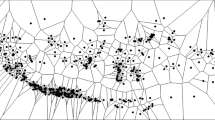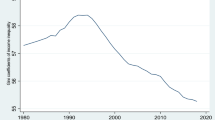Abstract—
The main goal of this work is to find ways to improve the regional system for monitoring income inequality in Russia. In our paper we compare methods of measuring income inequality that are currently used in official statistics with alternative methods. Alternative indicators include those used by international organizations and those appearing in the economic literature. The empirical basis for the analysis is formed by the microdata of the Statistical Survey of Personal Income and Participation in Social Programs, held by Rosstat in 2017. Based on the results of the study, a list of additional indicators that allow to reveal specific features of regional income inequality in Russia was proposed. We also identified the list of Russian regions for which the use of additional inequality indicators is most appropriate. We expect that using the extended set of income differentiation measures will provide policymakers with an important information to design effective responses to inequality.



Similar content being viewed by others
Notes
The heavy-tailed distribution is the probability distribution whose tails are not exponentially bounded, i.e., its tails are heavier than an exponential distribution.
World Bank. LAC Equity Lab. http://www.worldbank.org/en/topic/poverty/lac-equity-lab1/income-inequality/inequality-trends.
Russian Longitudinal Monitoring survey (RLMS-HSE), conducted by National Research University Higher School of Economics and “Demoscope” together with Carolina Population Center, University of North Carolina at Chapel Hill and the Institute of Sociology of the Federal Center of Theoretical and Applied Sociology of the Russian Academy of Sciences. (RLMS-HSE web sites: http://www.cpc.unc.edu/projects/rlms-hse, http://www.hse.ru/org/hse/rlms).
The main data source for the analysis of income inequality in Russian regions is Rosstat’s official publications. These publications provide information on income inequality both in Russia as a whole and in individual regions. The most complete set of indicators of income equality in Russian regions is presented in the publication “Social situation and standard of living of the population of Russia,” which Rosstat issues since 1997 (every year in 1997−2016 and every two years since 2016).
REFERENCES
Aivazyan, S.A., Analiz kachestva i obraza zhizni naseleniya (Analysis of the Quality of Life and Lifestyle of the Population), Moscow: Nauka, 2012.
Aivazyan, S.A., Model of the distribution of the population of Russia by average income per capita, Ekon. Matem. Metody, 1997, no. 4 (33), pp. 74–86.
Butaeva, K.O., The assesment of income disparity in Russia: the formation and use, Cand. Sci. (Econ.) Dissertation, Moscow, 2017. https://istina.msu.ru/dissertations/86906456/. Accessed March 20, 2020.
Bufetova, A.N., Interregional differences in living standards in Russia, Vestn. Novosib. Gos. Univ., Ser.: Sots.-Ekon. Nauki, 2014, no. 3 (14), pp. 113–123.
Ovcharova, L.N., Burdyak, A.Ya., Pishnyak, A.I., et al., Dinamika monetarnykh i nemonitarnykh kharakteristik urovnya zhizni rossiiskikh domokhozyaistv za gody postsovetskogo razvitiya: Analiticheskii doklad (Dynamics of Monetary and Non-Monetary Characteristics of the Standard of Living of Russian Households over the Years of Post-Soviet Development: Analytical Report), Moscow: Liberal’naya Missiya Fond, 2014.
Zubarevich, N.V., Disparity of regions and large cities of Russia: what has changed in 2010’s? Obshch. Nauki Sovrem., 2019, no. 4, pp. 57–70.
Zubarevich, N.V., Regiony Rossii: neravenstvo, krizis, modernizatsiya (Russian Regions: Disparity, Crisis, and Modernization), Moscow: Nezavisimyi Inst. Sots. Polit., 2010.
Kislitsyna, O.A., Neravenstvo dokhodov v Rossii v perekhodnyi period (Income Disparity in Russia during Transition Period), Moscow: Econ. Educ. Res. Consortium, 2003.
Kolmakov, I.B., Conjugation of the log-normal distribution of the population by the level of money income with the Pareto distribution, Audit Fin. Anal., 2015, no. 2, pp. 124–131.
Kolomak, E.A., Interregional disparity in Russia: economic and social aspects, Prostr. Ekon., 2010, no. 1, pp. 26–35.
Kolomak, E.A., Uneven spatial development in Russia: explanations of the new economic geography, Vopr. Ekon., 2013, no. 2, pp. 132–150.
Malkina, M.Yu., Institutional principles of income disparity in the modern economy, Zh. Inst. Issled., 2016, no. 1 (8), pp. 100–120.
Ovcharova, L.N., Popova, D.O., and Rudberg, A.M., Decomposition of factors of income disparity in modern Russia, Zh. Nov. Ekon. Assots., 2016, no. 3 (31), pp. 170–186. http://journal.econorus.org/pdf/NEA-31.pdf. Accessed April 30, 2019.
Sotsial’noe polozhenie i uroven’ zhizni naseleniya Rossii, 2017: Statisticheskii sbornik (Social Status and Standard of Living of the Population of Russia, 2017: Statistical Handbook), Sabel’nikova, M.K., Frolova, E.B., et al., Eds., Moscow: Rosstat, 2017. http://www.gks.ru/ wps/wcm/connect/rosstat_main/rosstat/ru/statistics/ publications/catalog/doc_1138698314188. Accessed May 13, 2019.
Suvorov, A.V., Dokhody i potreblenie naseleniya: makroekonomicheskii analiz i prognozirovanie (Incomes and Consumption of the Population: Macroeconomic Analysis and Forecasts), Moscow: MAKS Press, 2001.
Shevyakov, A.Yu., Possibilities and prospects of statistical data use to assess the scale of hidden income, Vopr. Stat., 2003, no. 6, pp. 12–22.
Shevyakov, A.Yu., Zharomskii, V.S., and Soptsov, V.V., Socioeconomic disparity and poverty: status and reduction approaches, Ekon. Nauka Sovrem. Ross., 2007, no. 3, pp. 62–74.
Shevyakov, A.Yu. and Kiruta, A.Ya., Izmerenie ekonomicheskogo neravenstva (Measurement of Economic Disparity), Moscow: Leto, 2002.
Shevyakov, A.Yu. and Kiruta, A.Ya., Neravenstvo, ekonomicheskii rost i demografiya: neissledovannye vzaimosvyazi (Disparity, Economic Growth, and Demography: Non-Studied Relationships), Moscow: M-Studio, 2009.
Bellu, L.G. and Liberati, P., Policy impacts on inequality: welfare based measures of inequality the Atkinson index, UN Food and Agriculture Organization, 2006. http://www.fao.org/docs/up/easypol/451/welfare_ measures_inequa_atkinson_050en.pdf. Accessed April 30, 2019.
Commander, S., Tolstopiatenko, A., and Yemtsov, R., Channels of redistribution: inequality and poverty in the Russian transition, Econ. Transition, 1999, vol. 2, no. 7, pp. 411–447.
Cowell, F., Measuring Inequality: Handbook of Economic Inequality, Oxford: Oxford Univ. Press, 2009. http://darp.lse.ac.uk/papersdb/cowell_ measuringinequality3.pdf. Accessed May 2, 2019.
Dang, H.-A., Lokshin, M., Abanokova, K., and Bussolo, M., Welfare dynamics and inequality in the Russian Federation during 1994–2015, Eur. J. Dev. Res., 2019, vol. 32, no. 2, pp. 1–35. https://link.springer.com/article/10.1057% 2Fs41287-019-00241-3#citeas. Accessed March 20, 2020.
Gastwirth, J., Is the Gini index of inequality overly sensitive to changes in the middle of the income distribution? Stat. Publ. Policy, 2017, vol. 4, no. 1, pp. 1–11. https://www.tandfonline.com/doi/full/10.1080/ 2330443X.2017.1360813. Accessed May 1, 2019.
Gorodnichenko, Y., Sabirianova, P.K., and Stolyarov, D., Inequality and volatility moderation in Russia: evidence from micro-level panel data on consumption and income, Rev. Econ. Dyn., 2010, vol. 13, no. 1, pp. 209–237.
Haughton, J. and Khandker, Sh., Handbook on Poverty and Inequality, Washington, DC: World Bank, 2009. https://openknowledge.worldbank.org/bitstream/handle/10986/11985/9780821376133.pdf. Accessed April 30, 2019.
Ibragimov, M. and Ibragimov, R., Heavy tails and upper-tail inequality: the case of Russia, Empirical Econ., 2018, vol. 54, no. 2, pp. 823–837. http://robustness.ru/media/publications/IbragimovIbragimovEE.pdf. Accessed May 1, 2019.
Ibragimov, M., Ibragimov, R., Karimov, J., and Yuldasheva, G., Robust Analysis of Income Inequality Dynamics in Russia: t-Statistic Based Approaches: The wiiw Balkan Observatory. Working Paper No. 105, Vienna: Vienna Inst. Int. Econ. Stud., 2012, pp. 1–37. https://wiiw.ac.at/robust-analysis-of-income-inequality-dynamics-in-russia-t-statis.pdf. Accessed May 2, 2019.
Lisina, A. and Van Kerm, P., Understanding inequality and poverty trends in Russia, Proc. Special IARIW-HSE Conf. “Experiences and Future Challenges in Measuring Income and Wealth in CIS Countries and Eastern Europe,” Moscow, 2019. http://ecineq.org/ecineq_paris19/papers_EcineqPSE/paper_322.pdf. Accessed March 20, 2020.
Novokmet, F., Piketty, T., and Zucman, G., From Soviets to oligarchs: inequality and property in Russia, 1905–2016, J. Econ. Inequality, 2018, vol. 16, no. 2, pp. 189–223. http://piketty.pse.ens.fr/files/NPZ2017WIDworld.pdf# page=34&zoom= 100,0,177. Accessed May 2, 2019.
Piketty, T., Capital in the Twenty-First Century, Cambridge, MA: Harvard Univ. Press, 2014.
Sheviakov, A. and Kiruta, A., Economic Inequality, Standards of Living and Poverty of Population in Russia, Moscow: CSEM, 2001.
Human Development Report 2016: Human Development for Everyone, Washington, DC: Commun. Dev., 2016. http://hdr.undp.org/sites/default/files/2016_human_ development_report.pdf. Accessed March 20, 2020.
Inequality measurement development issues no. 2, 2015. https://www.un.org/en/development/desa/policy/wess/wess_dev_issues/dsp_policy_02.pdf. Accessed May 1, 2019).
Wu, X. and Perloff, J., China’s income distribution, 1985–2001, Rev. Econ. Stat., 2005, vol. 87, no. 4, pp. 763–775. http://www.jstor.org/ stable/40042892. Accessed March 20, 2020.
Yemtsov, R., Through the looking-glass: What is behind official data on inequality in Russia over 1992–2003? Proc. 30th General Conference of the International Association for Research in Income and Wealth, Portoroz, Slovenia, Ottawa: Int. Assoc. Res. Income Wealth, 2008. http://www.iariw.org/papers/2008/yemtsov.pdf. Accessed May 2, 2019.
Funding
The article was written on the basis of the RANEPA state assignment research programme.
Author information
Authors and Affiliations
Corresponding authors
Ethics declarations
The authors declare no conflict of interest.
Rights and permissions
About this article
Cite this article
Maleva, T.M., Kartseva, M.A., Kuznetsova, P.O. et al. Does the Application of Alternative Methods Change the Pattern of Regional Inequality in Russia?. Reg. Res. Russ. 11, 18–28 (2021). https://doi.org/10.1134/S2079970521010093
Received:
Revised:
Accepted:
Published:
Issue Date:
DOI: https://doi.org/10.1134/S2079970521010093




